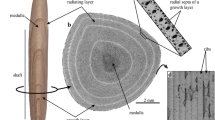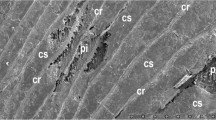Summary
The very first mineral deposits appearing in regenerating fractured adambulacral spines of Asterias rubens are minute polyhedrons that cover the surface of fractured trabeculae. Polyhedrons fuse together forming a fold from which a microspine differentiates. Microspines develop into long linear trabeculae which send out lateral processes at regular length intervals. Lateral processes from adjacent trabeculae fuse together, bridging the trabeculae and giving the regenerate the typical meshwork structure of stereom. Most of the regenerate is built up according to this growth pattern which ensures its longitudinal growth. Simultaneously, the initial fascicular stereom of the stub sends out short radial processes which branch into upward and downward directed subprocesses. The latter fuse with their equivalents located above or below, building up longitudinal rows of stereom meshes. These rows then bridge together by additional branched or unbranched lateral processes, so forming a new stereom layer which progressively covers the whole stub. Up to three new layers of stereom are formed in this way at the stub periphery. These become continuous with the stereom layers of the regenerate by fusion of reciprocal subprocesses, so ensuring the continuity between the stub and the regenerate. In both structures the first stage of mineralization results in an open stereom. Stereom thickening occurs in a second stage of mineralization (that is chronologically separated from the formation of the open stereom) and results in the differentiation of the original stereom fabrics (i.e. fascicular stereom). Regeneration of removed spines starts with the formation of a new spine base made of labyrinthic stereom. The development of the latter mostly relies on short branched and unbranched processes which fuse with each other or with predifferentiated meshes. After completion of its base, the regenerating spine lengthens and thickens similarly to the regenerating fractured spines. The diversity of the stereom growth processes observed in the present work may be reduced to the combination of one to three elementary events, viz. the development of long linear processes, of short unbranched processes and of short branched processes. A survey of the literature allows the suggestion that the implementation of these elementary events is sufficient to describe most types of stereom morphogenesis.
Similar content being viewed by others
References
Blake DB (1984) Constructional morphology and life habits of the Jurassic sea star Sphaeraster Quenstedt. N Jb Geol Paläont Abh 169:74–101
Domantay JS (1933) Development of the anchor and anchor-plate types of spicules of the synaptid Polyplectana kefersteinii (Selenka) and allied species. Philipp J Sci 52:371–379
Drager BJ, Harkey MA, Iwata M, Whiteley AH (1989) The expression of embryonic primary mesenchyme genes of the sea urchin Strongylocentrotus purpuratus in the adult skeletogenic tissues of this and other species of echinoderms. Dev Biol 133:14–23
Dubois Ph (1987) Ultrastructure des corps vitreux des astéries (Echinodermata). Bull Soc Sci Nat Ouest France Suppl HS 1987:35–40
Dubois Ph (1988) Tissu squelettique et calcification chez Asterias rubens L. (Echinodermata: Asteroidea). Thèse de Doctorat, Université Libre de Bruxelles, Bruxelles, Belgique
Dubois Ph, Chen CP (1989) Calcification in echinoderms. Echinoderm Studies 3:109–178
Dubois Ph, Jangoux M (1985) The microstructure of the asteroid skeleton (Asterias rubens). In: Keegan BF, O'Connor BDS (eds) Proceedings of the Fifth International Echinoderm Conference, Galway. AA Balkema, Rotterdam, pp 507–512
Emlet RB (1985) Crystal axes in recent and fossil adult echinoids indicate trophic mode in larval development. Science 230:937–940
Fewkes JW (1888) On the development of the calcareous plates of Asterias. Bull Mus Comp Zool 17:1–56, 5 Pls
Gemmill J (1914) The development and certain points in the adult structure of the starfish Asterias rubens L. Philos Trans R Soc London (B) 205:213–294
Gordon I (1926a) The development of the calcareous test of Echinus miliaris. Philos Trans R Soc London (B) 214:259–312
Gordon I (1926b) The development of the calcareous test of Echinocardium cordatum. Philos Trans R Soc London (B) 215:255–313
Gordon I (1929) Skeletal development in Arbacia, Echinarachnius and Leptasterias. Philos Trans R Soc London (B) 217:289–334
Gustafson T, Wolpert L (1963) The cellular basis of morphogenesis and sea urchin development. Int Rev Cytol 15:139–214
Harkey MA, Whiteley AH (1980) Isolation, culture and differentiation of echinoid primary mesenchyme cells. Wilhelm Roux's Arch 189:111–122
Heatfield BM (1971) Growth of the calcareous skeleton during regeneration of spines of the sea urchin, Strongylocentrotus purpuratus: a light and scanning electron microscope study. J Morph 134:57–90
Heatfield BM, Travis DF (1975) Ultrastructural studies of regenerating spines of the sea urchin Strongylocentrotus purpuratus. I. Cell types without spherules. J Morphol 145:13–50
Hendler G, Byrne M (1987) Fine structure of the dorsal arm plate of Ophiocoma wendti: evidence for a photoreceptor system (Echinodermata, Ophiuroidea). Zoomorphology 107:261–272
Hildeman WH, Dix TG (1972) Transplantation reactions of tropical Australian echinoderms. Transplantation 15:624–633
Hilgers H, Splechtna H (1979) Die Entwicklung ophiocephaler Pedizellarien von Sphaerechinus granularis (Echinodermata, Echinoidea). Zoomorphologie 93:265–287
Holland ND, Grimmer JC (1981) Fine structure of the cirri and a possible mechanism for their motility in stalkless crinoids (Echinodermata). Cell Tissue Res 214:207–217
Humphrey CD, Pittman FE (1974) A simple methylene blue-azure II-basic fuschin stain for epoxy-embedded tissue sections. Stain Technol 49:9–14
Hyman LH (1955) The invertebrates: IV. Echinodermata. McGraw-Hill, New York
Kinoshita T, Okazaki K (1984) In vitro study on morphogenesis of sea-urchin Hemicentrotus pulcherrimus larval spicule: adhesiveness of cells. Zool Sci (Tokyo) 1:433–443
Ludwig H (1882) Entwicklungsgeschichte der Asterina gibbosa Forbes. Z Wiss Zool 37:1–98
Macurda DB, Meyer DL (1975) The microstructure of the crinoid endoskeleton. Palaeontol Contrib Univ Kansas 75:1–22
Märkel K (1981) Experimental morphology of coronar growth in regular echinoids. Zoomorphology 97:31–52
Märkel K, Röser U (1983) Calcite resorption in the spine of the echinoid Eucidaris tribuloides. Zoomorphology 103:43–58
Mischor B (1975) Zur Morphologie und Regeneration der Hohlstacheln von Diadema antillarum Philippi und Echinothrix diadema (L) (Echinoidea, Diadematidae). Zoomorphologie 82:243–258
Murakami S (1941) On the development of the calcareous plates of an ophiuran, Amphipholis japonica Matsumoto. Japan J Zool 9:19–33
Okazaki K (1975) Normal development to metamorphosis. In: Czihak G (ed) The Sea urchin embryo. Springer-Verlag, Berlin, pp 177–232
Parks AL, Parr BA, Chin JE, Leaf DS, Raff RA (1987) Molecular analysis of heterochronic changes in the evolution of direct developing sea urchins. J Evol Biol 1:27–44
Richardson W, Kitajima T, Wilt F, Benson S (1989) Expression of an embryonic spicule matrix gene in calcified tissues of adult sea urchins. Dev Biol 132:266–269
Shimizu M, Yamada J (1980) Sclerocytes and crystal growth in the regeneration of sea urchin test and spines. In: Omori M, Watabe N (eds) The mechanisms of biomineralization in animals and plants. Tokai Univ Press, Tokyo, pp 169–178
Smith AB (1980a) Stereom microstructure of the echinoid test. Spec Pap Palaeontol 25:1–81
Smith AB (1980b) The structure and arrangement of echinoid tubercles. Philos Trans R Soc Lond (B) 289:1–54
Solursh M (1986) Migration of sea urchin primary mesenchyme cells. In: Browder LW (ed) Developmental Biology, Vol. 2. Plenum Publishing Corporation, New York, pp 391–431
Stricker SA (1986) The fine structure and development of calcified skeletal elements in the body wall of holothurian echinoderms. J Morphol 188:273–288
Théel H (1892) On the development of Echinocyamus pusillus. Nova Acta Regiae Soc Sci Ups (3) 15:1–57
Wilt FH (1987) Determination and morphogenesis in the sea urchin embryo. Development 100:559–576
Wolpert L, Gustafson T (1961) Studies on the cellular basis of morphogenesis of the sea urchin embryo. Development of the skeletal pattern. Exp Cell Res 2:311–325
Woodland W (1906) Studies in spicule formation. IV. The scleroblastic development of the spicules in Cucumariidae; with a note relating to the plate-and-anchor spicules of Synapta inhaerens. Q J Microsc Sci 49:533–559
Woodland W (1907) Studies in spicule formation. V. The scleroblastic development of the spicules in Ophiuroidea and Echinoidea, and in the genera Antedon and Synapta. Q J Microsc Sci 51:31–43
Author information
Authors and Affiliations
Additional information
Senior research assistant NFSR (Belgium)
Rights and permissions
About this article
Cite this article
Dubois, P., Jangoux, M. Stereom morphogenesis and differentiation during regeneration of adambulacral spines of Asterias rubens (Echinodermata, Asteroida). Zoomorphology 109, 263–272 (1990). https://doi.org/10.1007/BF00312193
Received:
Issue Date:
DOI: https://doi.org/10.1007/BF00312193




